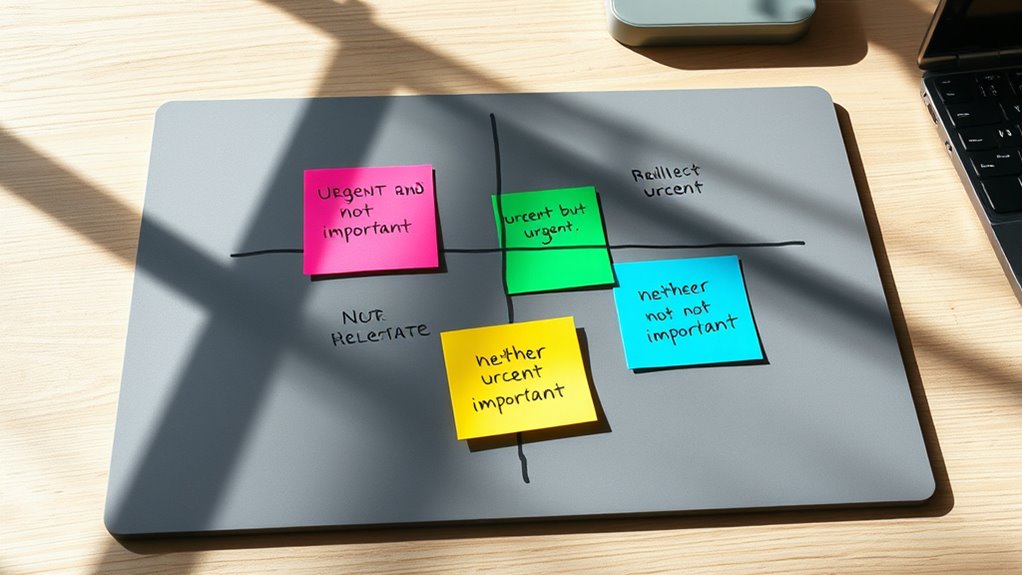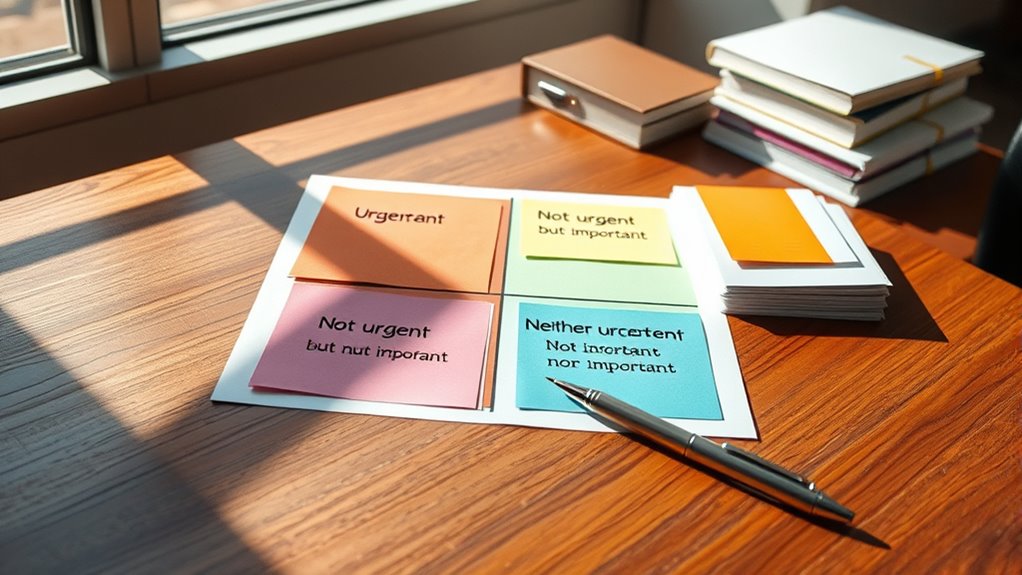To prioritize what truly matters, use the Eisenhower Matrix to sort tasks by urgency and importance. Focus on urgent and important activities first, then schedule time for important but not urgent ones to prevent stress later. Delegate or postpone tasks that are urgent but not important, and eliminate activities that are neither urgent nor valuable. Mastering this method helps you stay focused and effective—keep exploring to reveal even more productivity strategies.
Key Takeaways
- The Eisenhower Matrix helps distinguish urgent tasks from important ones to optimize prioritization.
- It categorizes tasks into four quadrants: urgent & important, important but not urgent, urgent but not important, neither.
- Focusing on important but not urgent activities prevents future crises and promotes long-term success.
- Delegating or eliminating tasks in less critical quadrants frees time for high-impact work.
- Consistent use develops productive habits, improves decision-making, and enhances overall time management.

Ever wonder how some people manage to stay productive and focused? The secret often lies in effective time management and smart productivity techniques. One powerful method to help you prioritize tasks and make the most of your day is the Eisenhower Matrix. This tool helps you distinguish between what’s urgent and important, allowing you to allocate your time wisely. When you’re overwhelmed with tasks, it’s easy to get caught up in busywork that doesn’t advance your goals. The Eisenhower Matrix cuts through the chaos by dividing your to-do list into four categories: urgent and important, important but not urgent, urgent but not important, and neither urgent nor important. Understanding these distinctions is key to applying effective productivity techniques and managing your time efficiently.
Start by identifying the tasks that fall into the urgent and important quadrant. These are your top priorities—deadlines, crises, or critical projects that demand immediate attention. Tackling these first ensures you’re addressing what truly matters and preventing small issues from snowballing. Next, focus on tasks that are important but not urgent. These are often overlooked but are essential for long-term success, such as planning, skill development, or relationship building. By scheduling dedicated time for these activities, you prevent them from becoming urgent and stressful later. The third category includes tasks that are urgent but not important. These might seem pressing but don’t greatly contribute to your goals, like certain interruptions or trivial requests. Delegating or minimizing these tasks frees up valuable time for more meaningful work. Lastly, tasks that are neither urgent nor important can often be eliminated or postponed altogether, clearing your schedule of distractions and low-value activities.
Using the Eisenhower Matrix as part of your daily routine enhances your time management skills and sharpens your productivity techniques. It encourages you to focus on what truly moves the needle rather than getting lost in busywork. As you become more familiar with this method, you’ll find it easier to set boundaries, say no to non-essential tasks, and prioritize high-impact activities. This not only boosts your efficiency but also reduces stress, giving you a clearer sense of control over your workload. Over time, applying this framework helps you develop habits that align your daily actions with your long-term goals. The more consistently you use the Eisenhower Matrix, the better you’ll become at making decisions quickly and confidently about what deserves your attention. Incorporating a clear understanding of Gold IRA options can also be a valuable part of your financial planning to secure your future. Ultimately, mastering this approach transforms how you manage your time, making productivity techniques more effective and helping you focus on what truly matters in both your work and personal life.
Frequently Asked Questions
How Can I Effectively Differentiate Urgent From Important Tasks?
To effectively differentiate urgent from important tasks, focus on their impact and deadlines. Urgent tasks demand immediate attention, like crises or deadlines, while important tasks contribute to your long-term goals. Use task categorization to prioritize, asking yourself if a task aligns with your values or objectives. This clarity helps you allocate time wisely, tackling urgent tasks promptly without neglecting important ones that drive growth and success.
What Tools Best Support Implementing the Eisenhower Matrix?
Ever wondered how to make your time management more effective? Digital apps like Todoist, Trello, or Microsoft To Do are perfect tools for implementing the Eisenhower matrix. They help you categorize tasks into urgent and important, set deadlines, and prioritize effortlessly. These apps keep your focus on what truly matters, streamline your workflow, and make certain you don’t overlook critical tasks. Isn’t it time to upgrade your productivity tools?
Can the Matrix Adapt to Personal and Professional Life?
Yes, you can adapt the Eisenhower Matrix to both personal and professional life. It helps you prioritize tasks, improving your time management and reducing stress. By categorizing responsibilities into urgent and important, you gain clarity and focus, making it easier to balance work and personal activities. This flexibility guarantees you stay organized and avoid burnout, ultimately leading to a more productive and stress-free lifestyle.
How Often Should I Reassess My Task Priorities?
You should reevaluate your tasks and update your priorities at least once a week, especially if your workload or goals change frequently. Regular task reassessment helps you stay aligned with what truly matters and ensures you’re not wasting time on less important things. Make it a habit to review your priorities daily or bi-weekly during your planning sessions, so you can adapt quickly and stay focused on your most important tasks.
What Are Common Pitfalls When Using the Eisenhower Matrix?
You might fall into common pitfalls like task misclassification, where urgent tasks are mistaken for important ones, leading to misplaced focus. Overcomplication can also happen if you try to analyze every detail, making the process overwhelming. To avoid these, stick to clear criteria, keep it simple, and regularly review your categories. This helps you stay focused on what truly matters without getting bogged down in unnecessary details.
Conclusion
Think of the Eisenhower Matrix as your personal compass, guiding you through busy days. Just like a chef sorts ingredients to create a perfect dish, you prioritize tasks to craft a balanced life. I once saw a friend use it to tackle a mountain of work, and within hours, she felt lighter and more focused. Remember, when you prioritize what matters, you turn chaos into clarity—making every moment count.










